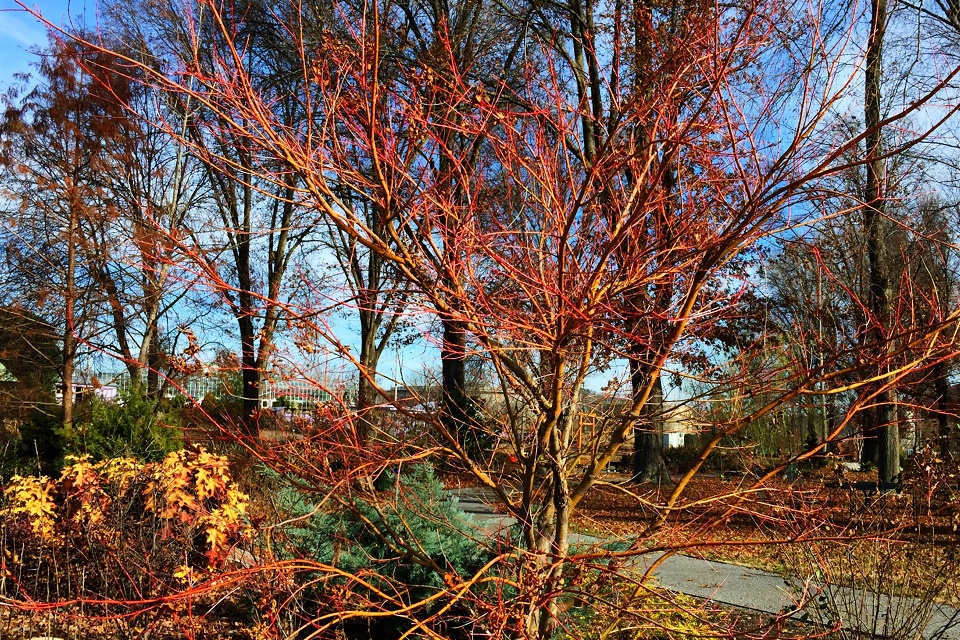
Add Certain Cultivars to Your Landscape for Winter Interest
From the UT Gardens
January 2017 Plant of the Month: Japanese Maple
Submitted by Sue Hamilton, Director of the University of Tennessee Gardens
Japanese maples, Acer palmatum, are at the top of my list of favorite trees. This group of trees has such diversity in growth habit, foliage color, leaf-type, form and even bark color that there really is an ideal selection for every garden. At last count, I have 18 different cultivars in my home landscape and my garden is only a half-acre!
You might be wondering why I’ve chosen to highlight them in January? For one, as long as the ground is not frozen, this is a great time to plant a Japanese maple or any tree or shrub. Woody plants have gone dormant and with the cooler temperatures and rainfall, it’s an ideal time to get such plants in the ground. Such plants typically outperform those planted in the spring. And secondly, I want to focus on the group of Japanese maples that make quite a show in the winter landscape. If you have space, don’t overlook adding this great winter-interest tree to your landscape.
Several Japanese maple selections are valued for the brilliant bark color they exhibit once temperatures turn cold. Each has an upright growth habit, and, depending on cultivar, can grow between 6 and 25 feet tall. Foliage is a lime green in spring darkening in color as summer approaches. Fall foliage is either a bright, showy shade of yellow or a fusion of red, orange and yellow. They perform best in a slightly acidic (pH 5.5-6.5) and moist but well-drained soil in full-sun to partial shade. Bark coloration will always be best when the tree is grown in full-sun and young twigs and branches will typically be more color intensive than the tree trunk itself. Coloration can almost be absent in summer. Some selections of this group of Japanese maples can lose their color intensity in the main trunk of the tree as they age.
Japanese maples really are easy trees to maintain. They are not heavy feeders, and using compost or a well-aged mulch well away from the base of the tree and about three to four inches deep will provide enough nutrition for your maple, making commercial fertilizers unnecessary. You may find that you would like to prune or shape your Japanese maple. This is a matter of preference. Remove crossing branches and thin out twigs that are bunched together. This will reveal and accentuate the beauty of the tree’s framework. The best time to prune Japanese maples in our region of the country is late February to early March. It’s recommended to use selective pruning practices, removing no more than one-third of the branches at one time or during one season.
I recommend siting your tree where it can be a focal point in your landscape. You can make it a single specimen planted in an open lawn. Nighttime landscape up-lighting is a fabulous way to showcase the beauty of the colorful bark and the architecture of the tree. Another effective way to distinguish this tree is to pay careful attention to the angle-of-view from which the tree will be seen in your garden and provide it a contrasting-color backdrop. It could be the background color of your home or utility shed or the contrasting color of an evergreen. Planting in a decorative container in a color matching the tree’s bark can be incredibly striking. Add to the winter color of this combination by planting pansies and violas with matching or contrasting flowers around the base of the tree. And Japanese maples, because they are not large trees, can always be used in mixed planting boarders and in foundation plantings.
Outstanding Selections for Winter Appeal:
- ‘Aka kawa hime’ has bright red bark in winter and is one of the more dwarf in this unique group of maples. Grows 6’-8’ tall and 4’-6’ wide.
- ‘Beni kawa’ also has bright salmon-red bark in winter. Grows 10’ tall and 8’-10’ wide.
- ‘Bihou’ has bark that turns orange in the winter. Grows 15 ‘tall and 8’-10’ wide, and can be viewed in the UT Gardens, Jackson.
- ‘Dixie Delight’ has bark that changes in the winter first to orange and then to yellow as temperatures get colder. Grows 10’-12’ tall and 6’-8’ wide.
- ‘Japanese Sunrise’ has multi-colored winter bark. One side of the tree will be bright red while the other side is a bright yellow. And in between these two colors, the bark is a fusion of yellow, orange and red. Can grow up to 25’ tall x 20’ wide. A specimen is on display in the UT Gardens, Knoxville.
- ‘Red Wood’ has coral-pink bark much like that of ‘Sango Kaku’. Known to keep good bark coloration in the old wood as well. Grows up to 12′ tall and 4’-8’ wide.
- ‘Sango kaku’ is known for its showy coral-pink coloration in the winter landscape. Grows up to 25’ tall and 20’ wide. Specimens are on display at both the UT Gardens sites in Knoxville and Jackson.
- ‘Winter Flame’ has showy red winter bark. Grows 8’-10’ tall and 6-8’ wide. You can also see this tree in the UT Gardens, Knoxville.
The UT Gardens includes plant collections located in Knoxville, Jackson and Crossville. Designated as the official botanical garden for the State of Tennessee, the collections are part of the UT Institute of Agriculture. The gardens’ mission is to foster appreciation, education and stewardship of plants through garden displays, educational programs and research trials. The gardens are open during all seasons and free to the public. For more information, see the Gardens website: ag.tennessee.edu/utg
Contact:
Susan Hamilton, UT Department of Plant Sciences